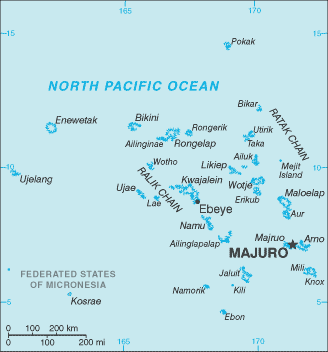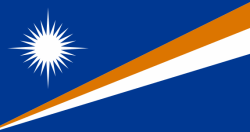Marshall Islands
Related Categories:
 Marshall Islands - Fotw
Marshall Islands - FotwThe deep blue background represents the Pacific Ocean. The white and orange bands represent the Ratak (Sunrise) and Ralik (Sunset) chains, respectively.
www.fotw.us/flags/mh.html Marshall Islands - wikipedia.org
Although they were settled by Micronesians in the 2nd millennium BC, little is known of the early history of the islands. Spanish explorer Alonso de Salazar was the first European to sight the Marshall Islands in 1526, but the islands remained virtually unvisited by Europeans for several more centuries, before the arrival of British Captain John Marshall in 1788; the islands owe their name to him.
en.wikipedia.org/
The Marshall Islands is comprised of 29 atolls and five single islands, which form two parallel groups--the "Ratak" (sunrise) chain and the "Ralik"(sunset) chain. Two-thirds of the nation's population lives in Majuro and Ebeye. The outer islands are sparsely populated due to lack of employment opportunities and economic development.
The Marshallese are of Micronesian origin, which is traced to a combination of peoples who emigrated from Southeast Asia in the remote past. The matrilineal Marshallese culture revolves around a complex system of clans and lineages tied to land ownership.
Virtually all Marshallese are Christian, most of them Protestant. Other Christian denominations include Roman Catholic, Seventh-day Adventist, Mormon, Salvation Army, and Jehovah's Witness. A small Bahai community also exists.
Marshallese is the official language. English is spoken to some extent by most of the adult urban population. However, both the Nitijela (parliament) and national radio use Marshallese.
The public school system provides education through grade 12, although admission to secondary school is selective. The elementary program employs a bilingual/bicultural curriculum. English is introduced in the fourth grade. Many Marshallese and American observers have lamented the poor state of the public education system as a major stumbling block to economic development. The Marshall Islands' largest secondary institution--the 2-year College of the Marshall Islands--has experienced U.S. accreditation problems since 2003. However, thanks to an increase in funding, it has shown steady improvement since and is heading toward full accreditation. The University of the South Pacific offers courses at a small campus on Majuro.
www.state.gov/r/
Introduction
About
Contact
Symbols in The News
Interpret this Symbol
AAC
African
AI
Alchemy
Alphabets
Ancient
Animal Symbolism
Architecture
Art
Articles
Astrology
Baha'i
Blissymbolics
Blueprint Symbols
Buddhist
Celtic Symbols
Cemetery
Chinese Symbols
Christian
Circle
City
Codes
Color
Conlangs
Crop Circles
Danger
Da Vinci Code
Designing Logos
Dictionaries
Dreams
Education
Egyptian Symbols
Electrical
Emoticons
Find Images
Fonts
Food
Fraternity
Hamsa
Healing
Heraldry
Hermetic
Highway Signs
Hindu
History
Hobo
Holiday
Icons
iConji
Islamic
Jain Symbols
Japanese, Kanji
Jewish
Justice
Law
Literary Symbolism
Mandalas
Map
Masonic
Math, Number
Meaning of Names
Medical
Middle East
Military
Miscellaneous
Money
Music
Mythology
Native American
Playing Cards
Power
Psychology
QiQiiKhu
Reiki
Religious
Runes, Norse
Sacred Geometry
Scientific
Science Fiction
Sorority
Sports
Symbols in the News
Tattoos
ThirteenSymbols
Tree of Life
Ursprache
Videos
Visual Languages
Weather
Web Codes
Wicca
Words
Writing Systems
Braille
Coinherence
Coptic
Cuneiform
Easter Island
Etruscan
Happy Human
Hebrew
Kokopelli
Linear B
Lotus
Love Symbols
Mandorla
Moon Alphabet
Nine Pointed Star
Om
Oz
Phonetic
Scarab Beetle
Silent
Theosophy
Unifon
About
Contact
Symbols in The News
Interpret this Symbol
AAC
African
AI
Alchemy
Alphabets
Ancient
Animal Symbolism
Architecture
Art
Articles
Astrology
Baha'i
Blissymbolics
Blueprint Symbols
Buddhist
Celtic Symbols
Cemetery
Chinese Symbols
Christian
Circle
City
Codes
Color
Conlangs
Crop Circles
Danger
Da Vinci Code
Designing Logos
Dictionaries
Dreams
Education
Egyptian Symbols
Electrical
Emoticons
Find Images
Fonts
Food
Fraternity
Hamsa
Healing
Heraldry
Hermetic
Highway Signs
Hindu
History
Hobo
Holiday
Icons
iConji
Islamic
Jain Symbols
Japanese, Kanji
Jewish
Justice
Law
Literary Symbolism
Mandalas
Map
Masonic
Math, Number
Meaning of Names
Medical
Middle East
Military
Miscellaneous
Money
Music
Mythology
Native American
Playing Cards
Power
Psychology
QiQiiKhu
Reiki
Religious
Runes, Norse
Sacred Geometry
Scientific
Science Fiction
Sorority
Sports
Symbols in the News
Tattoos
ThirteenSymbols
Tree of Life
Ursprache
Videos
Visual Languages
Weather
Web Codes
Wicca
Words
Writing Systems
Braille
Coinherence
Coptic
Cuneiform
Easter Island
Etruscan
Happy Human
Hebrew
Kokopelli
Linear B
Lotus
Love Symbols
Mandorla
Moon Alphabet
Nine Pointed Star
Om
Oz
Phonetic
Scarab Beetle
Silent
Theosophy
Unifon

